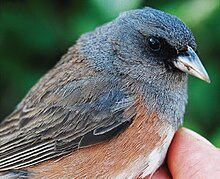Junco insularis
| Guadalupe junco | |
|---|---|
 |
|
| Scientific classification | |
| Kingdom: | Animalia |
| Phylum: | Chordata |
| Class: | Aves |
| Order: | Passeriformes |
| Family: | Emberizidae |
| Genus: | Junco |
| Species: | J. insularis |
| Binomial name | |
|
Junco insularis Ridgway, 1876 |
|
| Synonyms | |
|
Junco hyemalis insularis Ridgway, 1876 |
|
Junco hyemalis insularis Ridgway, 1876
The Guadalupe junco (Junco insularis) is a bird endemic to Guadalupe Island off Pacific Mexico. It is now usually considered distinct from the dark-eyed junco.
This American sparrow has a dull grayish head with a gray bill and brownish upperparts. Its wings and tail are blackish, though the tail has white edges. Its underparts are white with a rufous fringe at the bottom of the wings. It makes a high, sharp sik and a long series of chipping notes.
This bird is today found mainly in the Cupressus guadalupensis cypress grove on the island of Guadalupe, with a few birds in the remaining Guadelupe pine stands. Around 1900, it was known to utilize almost any habitat for breeding. It ranged over the whole island for feeding then, and indeed still does theoretically, but actually only a handful of flocks exist. A testimony to the adaptability of this junco is the fact that today a few birds breed at the seashore in non-native Nicotiana glauca tobacco shrub since this is dense enough to provide some protection from cats.
The breeding season is from February to June. Three to four eggs are laid in a bulky cup nest of dried grass stems, which is either in a depression in the ground or in the lower branches of a tree. The eggs are greenish white with reddish brown spots. If food is plentiful, the birds apparently breed twice a year.
This bird used to be abundant, but now only 50–100 adult birds are thought to survive. Goats introduced to provide food for fishermen and to start a meat-canning plant in the early-mid 19th century became feral and overran the island towards the late 19th century, with more than four goats per hectare (nearly two per acre) being present around the 1870s.Feral cats also multiplied, and as the habitat was destroyed by the goats the cats wreaked havoc on the endemic fauna. In 1897, Kaeding found the Guadalupe junco "abundant", but already decreasing due to cat predation. Anthony summed up 10 years of occasional visits in 1901 by noting that "...the juncos are slowly but surely becoming scarce." He blamed the interaction of goats, destroying habitat, and cats, destroying the birds themselves.
...
Wikipedia
